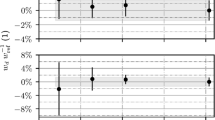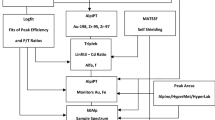Abstract
A derivative form of NAA is proposed which is based on the use of an endogenous internal standard of already known concentration in the sample. If a comparator with a known ratio of the determinand and endogenous standard are co-irradiated with the sample, the determinand concentration is derived in terms of the endogenous standard concentration and the activity ratios of the two induced nuclides in the sample and comparator. As well as eliminating the sample mass and greatly reducing errors caused by pulse pile-up and geometrical differences, it was shown that in the radiochemical mode, if the endogenous standard is chosen so that the induced activity is radioisotopic with that from the determinand, the radiochemical yield is also eliminated and the risk of non-achievement of isotopic exchange greatly reduced. The method is demonstrated with good results on reference materials for the determination of I, Mn and Ni. The advantages and disadvantages of this approach are discussed. It is suggested that it may be of application in quality control and in extending the range of certified elements in reference materials.
Similar content being viewed by others
References
G. Leliaert, J. Hoste, Z. Eeckhaut, Nature, 181 (1958) 600.
R. van Grieken, R. Gijbels, A. Speecke, J. Hoste, Anal. Chim. Acta, 43 (1968) 381.
R. Gijbels, J. Hoste, Anal. Chim. Acta, 41 (1968) 419.
T. C. Pung, T. Kato, Y. Oka, Bull. Chem. Soc. Japan, 44 (1971) 1031.
Y. Oka, T. Kato, H. T. Tsai, K. Nomura, Bull. Chem. Soc. Japan, 41 (1968) 329.
S. G. Chen, T. C. Pung, H. T. Tsai, S. C. Wu, Anal. Chim. Acta, 75 (1975) 212.
K. Masumato, M. Yagi, J. Radioanal. Nucl. Chem., 79 (1983) 57.
M. Yagi, K. Masumato, J. Radioanal. Nucl. Chem., 111 (1987) 359.
A. R. Byrne, I. Krašovec, Fresenius Z. Anal. Chem., 332 (1988) 666.
M. Dermelj, Z. Šlejkovec, A. R. Byrne, P Stegnar, V. Stibilj, M. Rossbach, Fresenius J. Anal. Chem., 338 (1990) 559.
M. Dermelj, A. R. Byrne, V. Stibilj, Trans. Am. Nucl. Soc., 74 (1996) 122.
A. R. Byrne, Fresenius J. Anal. Chem., 345 (1993) 144.
A. R. Byrne, Biol. Trace Elem. Res., 43–45 (1994) 529.
A. R. Byrne, J. Kučera, in: Proc. Intern. Symp. on Harmonization of Health-Related Environmental Measurements Using Nuclear and Isotopic Techniques, Hyderabad, India, 4–7 Nov. 1996, IAEA, Vienna, in press.
Author information
Authors and Affiliations
Rights and permissions
About this article
Cite this article
Byrne, A.R., Dermelj, M. An endogenous standard, radioisotopic ratio method in NAA. J Radioanal Nucl Chem 223, 55–60 (1997). https://doi.org/10.1007/BF02223363
Received:
Issue Date:
DOI: https://doi.org/10.1007/BF02223363




